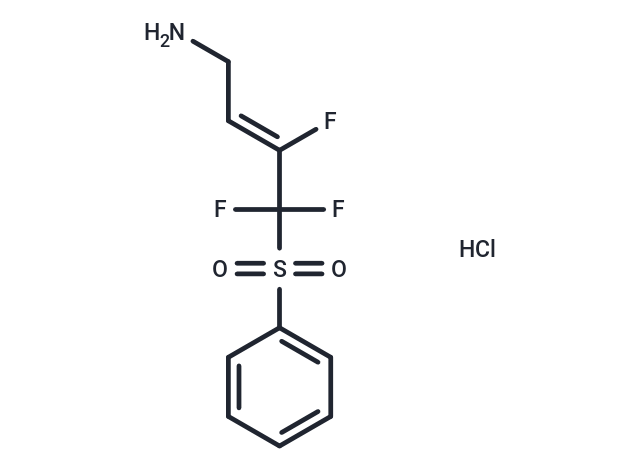Shopping Cart
Remove All Your shopping cart is currently empty
Your shopping cart is currently empty
PXS-6302 hydrochloride is a potent irreversible lysine oxidase (LOX) inhibitor, inhibiting Bovine LOX, rh LOXL1, rh LOXL2, rh LOXL3, and rh LOXL4 with IC50 of 3.7 μM, 3.4 μM, 0.4 μM, 1.5 μM, and 0.3 μM, respectively. PXS-6302 hydrochloride penetrates easily through the skin and is able to reduce collagen accumulation, significantly improving the appearance of scars.

| Pack Size | Price | USA Warehouse | Global Warehouse | Quantity |
|---|---|---|---|---|
| 1 mg | $228 | In Stock | In Stock | |
| 2 mg | $343 | In Stock | In Stock | |
| 5 mg | $575 | In Stock | In Stock | |
| 10 mg | $823 | In Stock | In Stock | |
| 25 mg | $1,450 | In Stock | In Stock | |
| 50 mg | $1,980 | In Stock | In Stock | |
| 100 mg | $2,630 | - | In Stock |
| Description | PXS-6302 hydrochloride is a potent irreversible lysine oxidase (LOX) inhibitor, inhibiting Bovine LOX, rh LOXL1, rh LOXL2, rh LOXL3, and rh LOXL4 with IC50 of 3.7 μM, 3.4 μM, 0.4 μM, 1.5 μM, and 0.3 μM, respectively. PXS-6302 hydrochloride penetrates easily through the skin and is able to reduce collagen accumulation, significantly improving the appearance of scars. |
| In vitro | PXS-6302 hydrochloride exhibits high permeability in monolayer cells, such as Caco-2 or MDCKII cells[1]. |
| In vivo | PXS-6302 hydrochloride inhibits LOX, reduces cross-linking, and improves the appearance of scars in porcine excision and burn models[1]. In a mouse injury model, topical application of PXS-6302 hydrochloride (1.5%, water-in-oil cream; 500 mg cream applied to 16 cm2; topical; once daily for 28 days) reduces collagen deposition and cross-linked proteins in the fibrotic tissue[1]. Additionally, PXS-6302 hydrochloride (0.5%, 1.5%, or 3%, water-in-oil ointment; 400 mg ointment applied to 16 cm2; topical; once daily for 12 weeks) significantly improves the appearance of scars without reducing tissue strength in a porcine injury model under local application[1]. |
| Synonyms | PXS-6302 hydrochloride (2584947-54-4 Free base) |
| Molecular Weight | 301.71 |
| Formula | C10H11ClF3NO2S |
| Cas No. | 2584947-79-3 |
| Smiles | S(C(/C(=C/CN)/F)(F)F)(=O)(=O)C1=CC=CC=C1.Cl |
| Relative Density. | no data available |
| Storage | store at low temperature | Powder: -20°C for 3 years | In solvent: -80°C for 1 year | Shipping with blue ice/Shipping at ambient temperature. | |||||||||||||||||||||||||||||||||||
| Solubility Information | DMSO: 50 mg/mL (165.72 mM), Sonication is recommended. | |||||||||||||||||||||||||||||||||||
| In Vivo Formulation | 10% DMSO+40% PEG300+5% Tween-80+45% Saline: 1.67 mg/mL (5.54 mM), Sonication is recommeded. Please add the solvents sequentially, clarifying the solution as much as possible before adding the next one. Dissolve by heating and/or sonication if necessary. Working solution is recommended to be prepared and used immediately. The formulation provided above is for reference purposes only. In vivo formulations may vary and should be modified based on specific experimental conditions. | |||||||||||||||||||||||||||||||||||
Solution Preparation Table | ||||||||||||||||||||||||||||||||||||
DMSO
| ||||||||||||||||||||||||||||||||||||
| Size | Quantity | Unit Price | Amount | Operation |
|---|

Copyright © 2015-2026 TargetMol Chemicals Inc. All Rights Reserved.